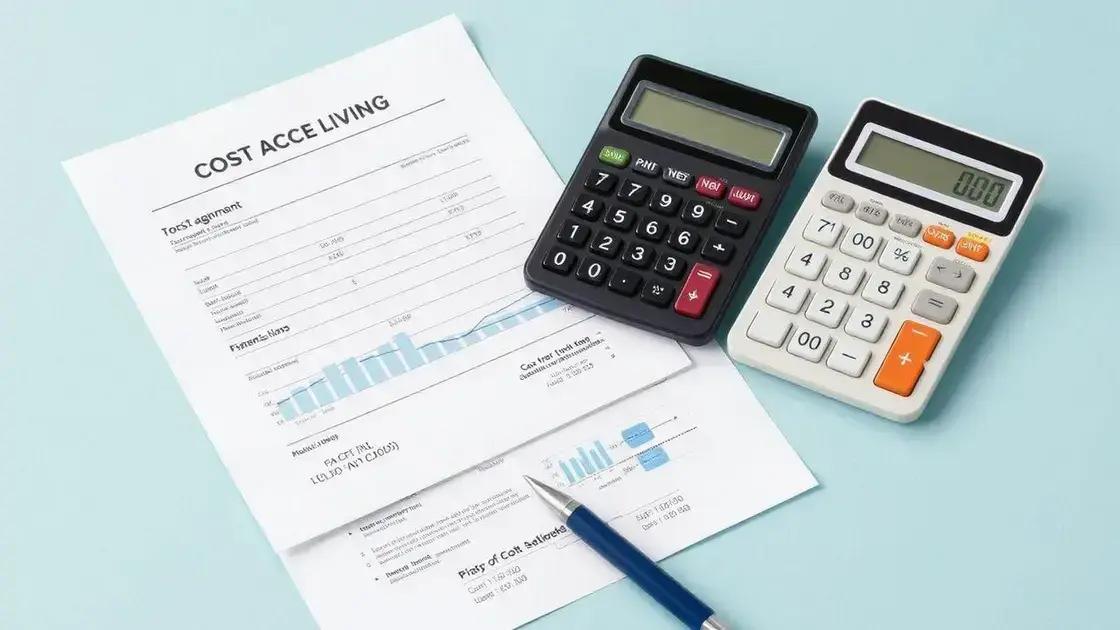Dollar depreciation: what it means for your finances

Anúncios
Dollar depreciation refers to the decline in the value of the U.S. dollar relative to other currencies, impacting purchasing power, increasing prices, and affecting investments and financial stability.
Dollar depreciation can significantly affect your daily life, from the prices of goods to international travel costs. Have you ever wondered how fluctuations in currency values affect your wallet? Let’s dive into the implications and what you can do to navigate this landscape.
Anúncios
Understanding dollar depreciation
Understanding dollar depreciation is crucial for anyone who manages personal finances or invests. When the value of the dollar decreases compared to other currencies, it can create various impacts on the economy and individual purchasing power.
What is dollar depreciation?
Dollar depreciation refers to the decline in value of the U.S. dollar relative to other currencies. This can happen for many reasons, including economic conditions, inflation rates, or changes in interest rates. A weaker dollar means that it takes more dollars to purchase products from other countries.
Anúncios
Causes of dollar depreciation
Several factors contribute to the depreciation of the dollar. These include:
- Inflation: When prices rise, the purchasing power of the dollar decreases.
- Interest rate changes: Lower interest rates can lead to decreased foreign investment, weakening the dollar.
- Trade balance: A trade deficit means more dollars are circulating outside the U.S., which can lower the dollar’s value.
- Political stability: Uncertainty in U.S. politics can also erode confidence in the dollar.
Each of these factors shows how interconnected global economies are and how sensitive the dollar is to changes. When foreign investors lose confidence in the U.S. economy, they may pull their investments, leading to a drop in the dollar’s value.
Effects on daily life
The impacts of dollar depreciation can be seen in everyday life. Imported goods become more expensive, affecting the prices of electronics, clothing, and even food. Travelers may find that their dollars don’t stretch as far when they go abroad. Moreover, this can lead to higher inflation domestically, as businesses pass on increased costs to consumers.
Understanding these effects can help consumers and investors make better decisions. Being aware of a depreciating dollar can motivate individuals to adjust their spending habits, savings, and investment strategies.
Causes of dollar depreciation
There are several key factors that contribute to dollar depreciation. Understanding these causes can help individuals better navigate financial decisions and market changes.
Inflation
Inflation occurs when prices rise across the economy, decreasing the purchasing power of the dollar. As inflation increases, consumers can buy less with the same amount of money, leading to depreciation.
Interest Rates
Another significant cause is the behavior of interest rates. When the Federal Reserve lowers interest rates, it can lead to less attractive investment opportunities in the U.S. This decrease often results in foreign investors moving their capital to countries that offer higher returns, causing the dollar to weaken.
- Lower returns: Investors seek better returns elsewhere.
- Increased money supply: More dollars in circulation can drive value down.
- Debt levels: High national debt can shake confidence in the currency.
Changing economic conditions also play a role. For example, if there’s political instability or unfavorable economic data, confidence in the U.S. dollar can diminish. When investors lose faith, they may sell their holdings, leading to further depreciation.
Trade Balance
The trade balance of a country is another vital element. A trade deficit occurs when a country imports more than it exports, leading to an excess of dollars abroad. This can reduce demand for the dollar, making it weaker against other currencies.
Understanding these causes of dollar depreciation helps individuals and businesses prepare for potential changes in their financial situations, paving the way for smarter financial planning.
Effects on purchasing power

The effects of dollar depreciation on purchasing power are significant and can impact everyone from consumers to businesses. When the value of the dollar decreases, it means that the dollar buys less than before.
Increase in Prices
One of the most immediate effects is the rise in prices for imported goods. As the dollar weakens, companies must pay more to buy products from other countries. This increase is often passed on to consumers, leading to higher prices at stores.
Impact on Household Budgets
Higher prices affect household budgets directly. Essentials like food, gas, and clothing may cost more. Families may find themselves adjusting their spending habits to cope with these rising costs.
- Reduced savings: Less money available for savings as more is spent on daily necessities.
- Change in consumption: Families might prioritize essential items over luxury goods.
- Increased borrowing: Some may resort to loans to keep up with rising costs.
The purchasing power erosion can create a cycle of financial strain. Consumers may delay purchases, affecting businesses and leading to slower economic growth. As people cut back on spending, businesses may also experience a decline in profits.
International Travel
For those who travel abroad, dollar depreciation can be particularly challenging. When the dollar is weaker, travelers find that their money does not go as far in foreign countries. This can lead to higher costs for hotels, meals, and activities while traveling.
Understanding these effects is crucial for planning budgets and making informed purchasing decisions. When facing a depreciating dollar, individuals and families need to adapt their financial strategies to maintain their purchasing power.
Strategies to mitigate financial impact
When dollar depreciation occurs, it can create financial challenges. However, there are effective strategies that individuals and businesses can use to mitigate the impact on their finances.
Diversify Investments
Diversifying investments is one of the best ways to protect against economic changes. By spreading investments across different asset classes, such as stocks, bonds, and commodities, investors can reduce risk. This means that if the dollar weakens, other investments may still perform well.
Consider Foreign Assets
Investing in foreign assets can also be beneficial. When the dollar depreciates, foreign investments may increase in value when converted back into dollars. This helps in preserving wealth even in a declining dollar environment.
- Exchange-traded funds (ETFs): Look for ETFs that hold international stocks or bonds.
- Real estate: International real estate can also serve as a hedge against dollar depreciation.
- Precious metals: Gold and silver often hold value during economic instability.
Another important strategy is to adjust spending habits. Being mindful of discretionary expenses can help mitigate the effects of rising prices due to dollar depreciation. Cutting unnecessary costs allows for a buffer against inflation.
Locking in Prices
Trying to lock in prices for essentials can also be useful. This can mean buying bulk items or securing contracts for services at fixed rates. For businesses, it is smart to negotiate fixed-price contracts with suppliers to avoid rising costs later.
Educating oneself about currency fluctuations can empower consumers to make informed decisions. Awareness of the financial landscape enables better timing for purchases and investments.
Future predictions for the dollar
Future predictions for the dollar involve a mix of optimism and caution. Many factors will influence how the dollar performs over the coming years.
Economic Recovery
As the global economy recovers from downturns, the dollar may strengthen. If the U.S. continues to grow economically, demand for the dollar can increase. This could lead to appreciation as investors seek safer assets in times of uncertainty.
Inflation Trends
However, inflation remains a serious concern. If inflation rates rise too quickly, it could erode the dollar’s value. A weak dollar means that consumers will face higher prices for goods and services.
- Economic policies: The effectiveness of government policies will play a critical role in managing inflation.
- Interest rates: Analysts predict that the Federal Reserve may increase rates to combat inflation.
- Geopolitical events: International tensions can also affect investor confidence in the dollar.
Another key factor is the demand for the dollar in international trade. As more countries adopt alternative currencies, the dollar could see a decrease in its dominant position in global markets. This shift could lead to volatility in its value and make future predictions uncertain.
Market Sentiment
Investor sentiment around the dollar will also be important. If investors feel confident in the U.S. economy, they are likely to invest more in dollar-denominated assets. This could stabilize or even strengthen the dollar. In contrast, economic uncertainty may lead to a decline in demand.
It is essential to monitor trends closely, as they will shape the future of the dollar. Understanding these dynamics helps consumers and businesses plan for potential changes in value and purchasing power.
\n
\n
\n
FAQ – Frequently Asked Questions about Dollar Depreciation
What causes dollar depreciation?
Dollar depreciation is primarily caused by factors like inflation, interest rate changes, and trade imbalances.
How does dollar depreciation affect purchasing power?
When the dollar depreciates, it loses value, making imported goods and everyday items more expensive for consumers.
What strategies can help mitigate the effects of a depreciating dollar?
Investing in diverse assets, reducing discretionary spending, and locking in prices can help individuals and businesses cope with depreciation.
What are the future predictions for the dollar?
Future predictions for the dollar depend on economic recovery, inflation trends, and global demand, causing variable confidence in the currency.






